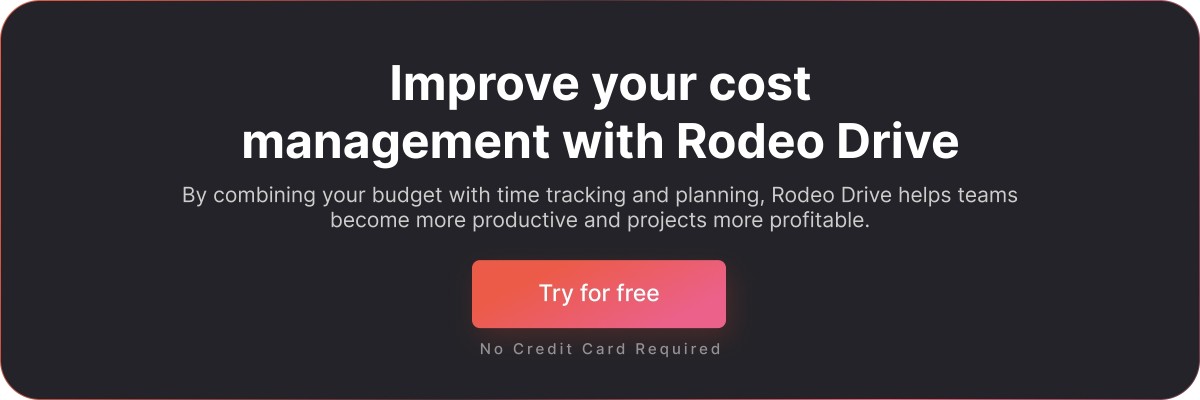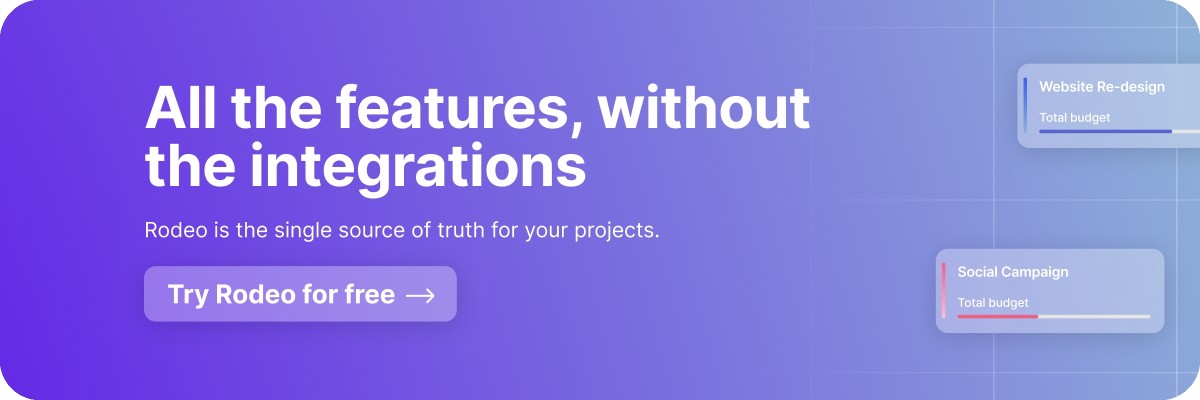Calculating Project Cost Variance: A How-to Guide
Sometimes projects don’t go the way you expect them to. Luckily, minor changes to project phases or activity assignments are normal and expected.
But, if your spending significantly differs from the estimated project costs outlined in your budget, then you may find yourself in trouble. And if you wait too long to fix the situation, then your ability to deliver the project within budget may be in jeopardy.
This is why cost variance is a crucial metric for project managers to track. As we’ll explore in this blog, your cost variance illustrates whether your team’s project spending is in line with expectations, allowing you to quickly course-correct if necessary.
Without further ado, let’s get started.
What is cost variance in project management?
Cost variance is a way that project managers can evaluate the financial performance of their projects by comparing their expected project budget against the amount they actually spent.
Tracking cost variance throughout the project lifecycle helps paint a clearer picture of whether a project is operating over or under budget. This way, project managers have the information they need to make the necessary adjustments to their projects to guarantee the desired budget results.
Cost variance is just one piece of the earned value management (EVM) technique, wherein the project manager uses scope, time, and spending to forecast project outcomes. Earned value management always focuses on money as the source of a project’s value.
Cost variance can be calculated in a few different ways depending on the context of your project and the level of detail you’re looking for. If you’re adopting an EVM approach, cost variance can be calculated according to the following formula:
Cost Variance (CV) = Earned Value (EV) – Actual Cost (AC)
But on a more basic level, the cost variance calculation looks like this:
Cost Variance (CV) = Budgeted Cost (BC) – Actual Cost (AC)
Note that a positive cost variance means that the project is under budget, and a negative cost variance means that the project is over budget, as the actual cost of the project exceeds the earned value. A result of zero — or near zero — means you’re on budget.
Related: 8 Tips to Keep Projects Under Budget
Why measure cost variance?
Any project manager can tell you the importance of monitoring your budget spending as your project moves through its various stages, and cost variance can help you do just that.
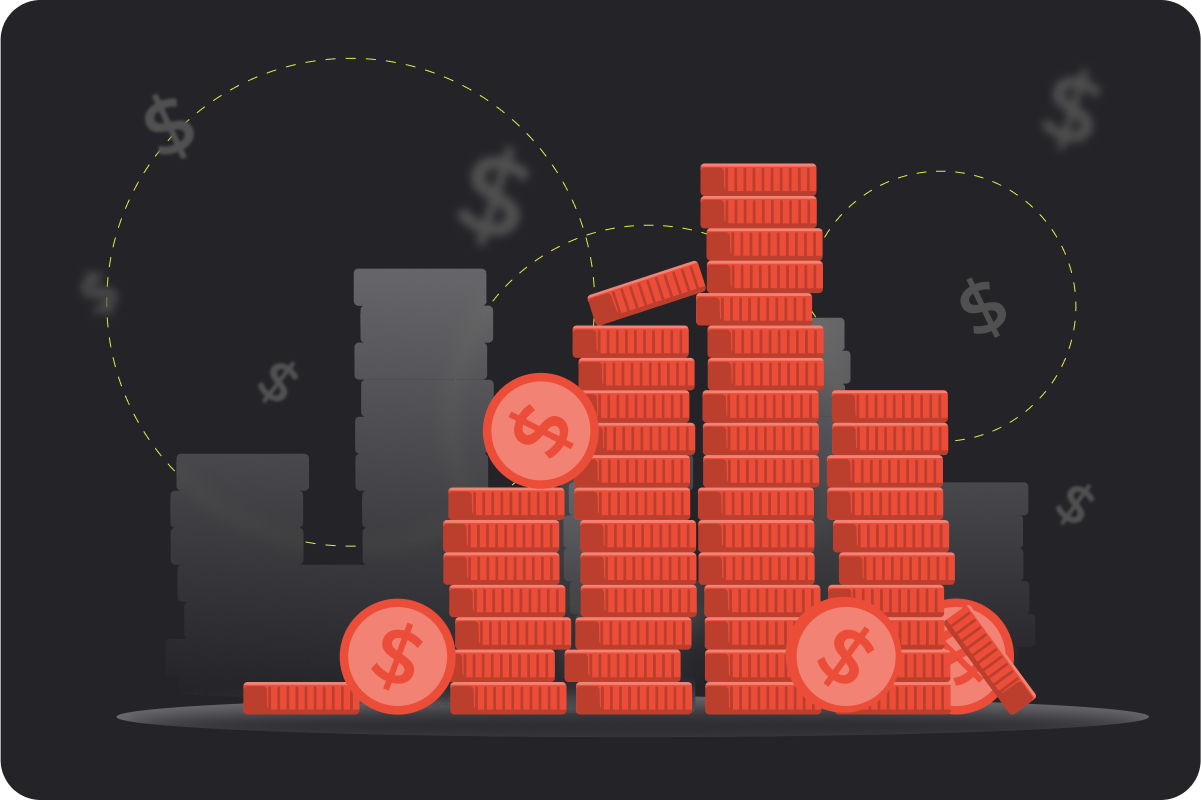
Calculating cost variance will tell you how your team’s spending lines up with your budget, which enables you to make changes to your team’s financial plans. Perhaps your team overspent significantly during the planning phase and needs to cut non-essential expenses during the next step of the project, for instance.
Going through your project without measuring cost variance might land you in hot water if you complete the project only to realize you spent more than you should’ve.
Without a system of measuring whether your budget is on track, you won’t know when adjustments need to be made. Plus, failing to prevent overspending might damage your client relationships.
Related: Project Cost Management: Everything You Need to Know
When is cost variance measured?
The frequency of your cost variance analysis is entirely up to you and your team. Start by scheduling it to occur regularly, such as on a weekly, quarterly, or monthly basis. You might also want to do so at the end of every project phase, in which case you’d subtract your actual costs from your budgeted costs.
But if you suspect that your team is overspending at any point throughout the project, you can easily calculate cost variance at any point. This is when you’d want to use the earned value formula. Later on in this blog, we’ll also provide a few other related formulas that can help you keep your project finances on track.
Types of project costs
Projects have several different types of project costs that all contribute to cost variance. Some project costs clearly and directly impact the production of project deliverables, whereas others are more indirect. Let’s take a look at the costs you’ll need to track.
Direct costs
Direct costs are expenses directly related to the production of project deliverables. Most project costs likely fall into this category, including things like equipment or materials.
Indirect costs
Often called overhead costs, your indirect costs go toward behind-the-scenes expenses that are necessary for project completion. An indirect cost might benefit several different projects at once, rather than only contributing to a single one.
Rent for office space is considered an indirect cost, as having a place for team members to work together is necessary for the completion of all projects, even if that’s not directly reflected in the deliverables of a particular project.
Fixed costs
Your fixed costs are your expenses that do not change as the project progresses. These are usually your project expenses that are a flat fee, such as rent for an office space. Because fixed costs don’t fluctuate, they are highly predictable costs that are far less likely to harm your project budget.
Variable costs
Variable costs are the opposite of fixed costs, meaning they often fluctuate — sometimes to a large degree. The materials your team is using for a project deliverable might be considered a variable cost as if you need more materials than you initially estimated, that’s going to cost you more than you budgeted for. Both direct and indirect costs can be categorized as either fixed or variable costs.
Variations of the cost variance formula
Although the basic cost variance formula is helpful, sometimes it doesn’t provide all of the information you need for sufficient cost control.
The below formulas use the same information as cost variance but their slight differences can leave you with other important takeaways regarding the health of your project budget.
Related: 50 Important Project Management Terms You Need to Know
Cost variance percentage
Whereas the general cost variance calculation will pinpoint your exact budget discrepancy, your cost variance percentage will yield the percentage that your budget is over or under by.
Your cost variance percentage might be a more easily understood metric for stakeholders or clients who have less of a grasp of the ins and outs of your budget. Plus, if you’ve already calculated your cost variance, then determining the percentage is an easy calculation.
Here’s the formula:
Cost Variance Percentage = Cost Variance (CV) / Earned Value (EV)
Cost performance index (CPI)

Your cost performance index is a metric used to determine the resource efficiency of your project alongside how well you’re sticking to your initial budget. The CPI calculation compares the value of the work completed by your team against the money you’ve spent on the project.
The formula is as follows:
Cost Performance Index (CPI) = Earned Value (EV) / Actual Cost (AC)
In terms of interpreting the results of this formula, any value that’s less than or equal to 1 means that your resources are not being used efficiently. Conversely, a result that’s greater than or equal to 1 means your resources are being properly used.
Also read: Benchmarking in Project Management: Definition, Approaches, and Best Practices
To complete cost performance index (TCPI)
Whereas a basic cost performance index calculation will help you interpret your use of resources up until the time of calculation, the TCPI metric is used to determine how your team must use resources for the remainder of the project in order to stay within budget.
To get your TCPI, follow this formula:
TCPI = (Total Budget – Earned Value) / (Total Budget – Actual Value)
Tips to keep your cost management under control
Cost variance is just one part of project cost management. You’ll also need to build budgets, track risks, and ensure that all of your expenditures are properly recorded, among many other tasks.
Take a look at three of our best tips for adopting a cost management process that will help you deliver projects within the expected budget:
1. Don’t cut corners when building your budget
As you’ve seen by now, your budget plays a crucial role in your cost variance calculations. Investing time into a budget that’s realistic and accounts for everything is one of the best ways to set yourself up for success.
This means you’ll need to think through the tasks and activities involved in each phase, as well as how long each activity will take to complete so that you properly account for the cost of your team’s time.
You might want to run your budget by a few members of your team before sending it to your client for approval. This way, if you’ve underestimated time requirements or accidentally left off any expenses, you can fix them ahead of time.
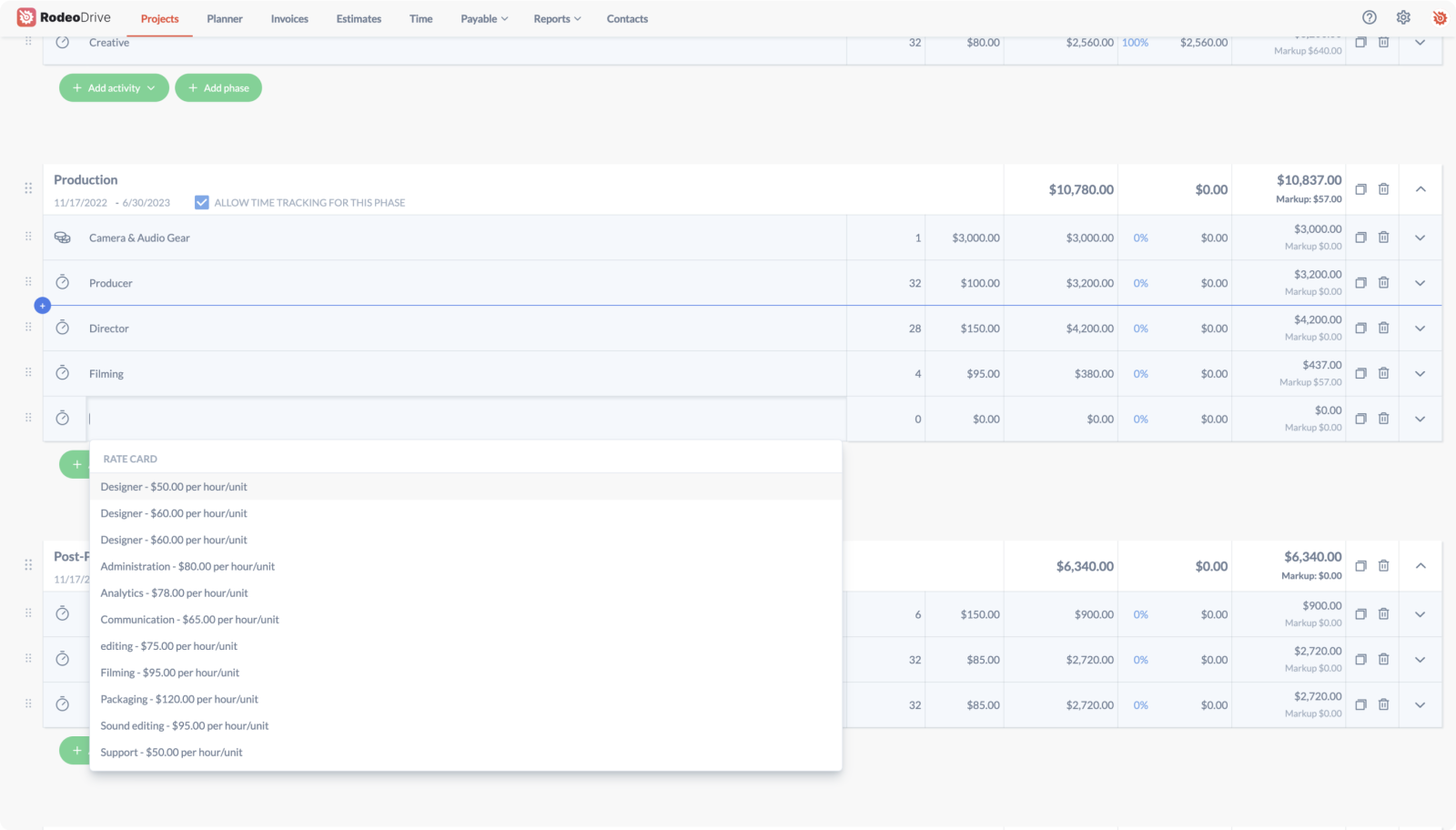
Wondering which budgeting approach you should adopt? Check out our guide for a breakdown of the differences between top-down and bottom-up budgeting.
2. Assess your risks ahead of time
Risk management and cost management are intertwined, as an unexpected risk can be costly for a project, potentially leading to significant overspending. This is why you should get started on your risk management as early as possible — ideally during the planning phase of your project.
This process doesn’t need to be extremely complicated or time-consuming. Rather, start by thinking through the pieces of your project with a high potential for going wrong, prioritize them by their likelihood of occurring, and brainstorm mitigation strategies. Assigning a team member to monitor each risk is another best practice.
Worried about scope creep posing a risk to your project? Check out our tips for handling last-minute scope changes.
3. Immediately record your incurred expenses
Picture this: You’ve hit the one-month mark on a project, and you’re calculating your cost variance for the first time. So far, your calculations suggest that your team is coming in under budget.
Except, not all of your team’s expenses have been tracked yet. So although it looks like your team is on track, these unrecorded expenses might mean you’re actually over budget without realizing it.
This is just one example of how failing to promptly track your project expenses can have negative consequences on your cost variance calculations. Instead, tracking your expenses immediately will ensure that your cost variance is always accurate.
Using a project management tool is another way to help ensure that expense tracking is built into your team’s processes to prevent anything from slipping through the cracks.
Using Rodeo Drive to improve your project cost management
Project budgets and cost variances have a lot of moving parts. Your project budget might be on track one week and completely off the next, which is why it requires such close monitoring. Unfortunately for project managers, this can be a time-consuming task.
That’s why we created Rodeo Drive, a project management software meant to help creatives and other project-based teams streamline their workflows. Rodeo Drive provides all of the necessary features your team needs to manage their project finances, including budgeting, invoicing, estimating, and reporting.
But that’s not all — Rodeo Drive is an all-in-one solution, meaning you can plan project activities, track time, and manage your client contact information within the platform as well.
Our goal is to make the lives of project managers easier, and we promise that our platform will save you time by bringing these features together and eliminating the need to switch between third-party apps.
Here are the features we excel in with regard to cost management:
Create phase-based budgets in just a few clicks
Creating a budget using a spreadsheet template can take hours. Rodeo Drive speeds up this process by allowing you to create phase-based budgets that are automatically totaled up for you.
While building a budget, simply add a new project phase, and enter the relevant time or expense activities within each phase. Entering rate cards for each of your team members can speed up the process, or you can customize the hourly rate for each activity directly on your budget. You can also add markups to your expenses.

Once your budget is complete, you’ll be able to send it to your client as an estimate for easy approval directly from Rodeo Drive.
Built-in time tracking that’s connected to your budget
Tracking time spent on project activities is a key part of determining your actual costs for a project. After all, how can you understand the value of your team’s time if you don’t have a clear understanding of the number of hours worked?
Rodeo Drive makes time tracking simple by allowing your team to track time in two ways. They can either begin their live timer when they start a task or simply add a timecard later on.
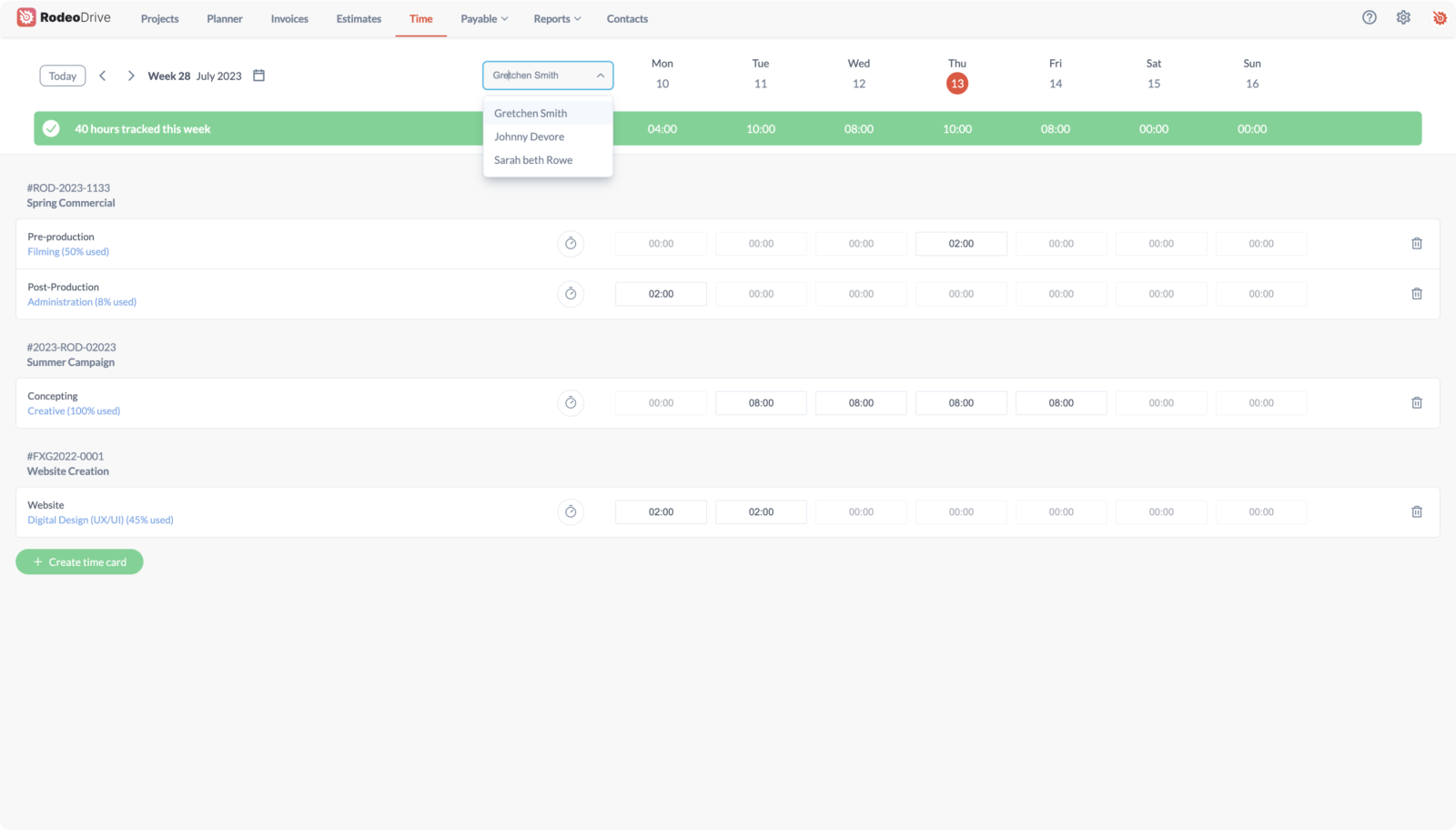
The best part is, all time tracked in Rodeo Drive must be connected to a project activity, which means that your budget will automatically update in real time as your team works.
This allows you to easily see how much of your budget you’ve already used up without having to do any manual calculations. Just imagine how much easier it’ll be to calculate your cost variance with Rodeo Drive’s real-time budget updates.
Access reports on financial performance, employee productivity, and more
If you calculate your cost variance and realize it’s significantly higher than it should be, you’ll want to have all of the right information to know how you can fix the situation.
Rodeo Drive compiles all of your team’s usage data into your “Reports” tab, bringing you insights into your team’s time registration, employee productivity, and financial insights like profitability.
.png)
Having these reporting insights easily accessible throughout your project makes it easy to identify a project phase that was more costly than anticipated or when a team member doesn’t have a high enough billable rate.
But don’t just take our word for it. Come try Rodeo Drive for yourself and see what the platform is all about. It’s entirely free — you don’t even need to enter your credit card information.





